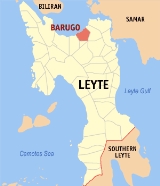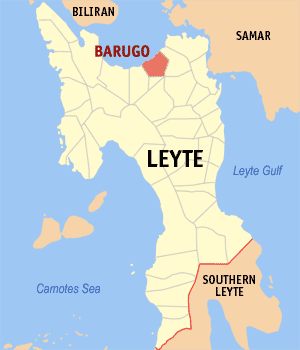
Barugo, Leyte
Encyclopedia

Philippines
The Philippines , officially known as the Republic of the Philippines , is a country in Southeast Asia in the western Pacific Ocean. To its north across the Luzon Strait lies Taiwan. West across the South China Sea sits Vietnam...
. According to the 2000 census, it has a population of 26,919 people in 5,108 households. Residents of the town of Barugo are traditionally referred to as Barugon-on; often, they're incorrectly referred to as baruguenos.
History of Barugo
Barugo is a townTown
A town is a human settlement larger than a village but smaller than a city. The size a settlement must be in order to be called a "town" varies considerably in different parts of the world, so that, for example, many American "small towns" seem to British people to be no more than villages, while...
in the northern coastal part of Leyte facing Carigara Bay, 50 kilometers northwest of Tacloban City
Tacloban City
The City of Tacloban is a port city approximately 360 miles southeast of Manila. It is the first in Eastern Visayas to be classified as a Highly Urbanized City. It is the capital of the Philippine province of Leyte and is the largest city in terms of population in Eastern Visayas...
, whose history dates back to the early days of Spanish occupation. Residents of the town of Barugo are traditionally referred to as Barugon-on.
Early during the Spanish rule, the area was given the status of a pueblo (town) when it was established as an "encomienda." An encomienda was a land estate awarded to deserving Spaniards for services rendered to the Spanish Crown. The grantee of an encomienda, known as encomiendero, was given the right to rule the encomienda in accordance with the Spanish laws and to extract tributes from the natives, part of which went to the Spanish Crown.
Miguel Lopez, the first governor of the Islas Pilipinas, started the practice of designating large landed estates as encomiendas. Only ten months after Cebu and Manila became encomiendas, Barugo was also designated as one on November 3, 1571. Rodrigo de Vargas was the first encomiendero for Barugo.
The education of the natives in Leyte started with the arrival of the Jesuits on July 16, 1595. The mission schools in the beginning concentrated on the basics of Christianity. Barugo initially was only a "vista" of Carigara, meaning that it was under the administrative and spiritual supervision of the curate of Carigara, and was under the care of Fr. Mateo Sanchez, who eventually became its first parish priest after Barugo was declared as an independent parish. It was Fr. Sanchez who established the first church in Barugo.
The Jesuits
Society of Jesus
The Society of Jesus is a Catholic male religious order that follows the teachings of the Catholic Church. The members are called Jesuits, and are also known colloquially as "God's Army" and as "The Company," these being references to founder Ignatius of Loyola's military background and a...
stayed in Leyte from 1595 to 1767. During that time they expanded their influence starting from Carigara and Barugo, in the hinterlands of Ogmuc (Ormoc), Dulac (Dulag), Palo, Alangalang, Malibago (?) and the entire island of Cibabaw (Samar). When Carlos III
Charles III of Spain
Charles III was the King of Spain and the Spanish Indies from 1759 to 1788. He was the eldest son of Philip V of Spain and his second wife, the Princess Elisabeth Farnese...
of Spain ordered the expulsion of the Jesuits from all Spanish dominions in 1767, the Jesuit mission on Leyte was handed over to the Augustinian Fathers. And later in 1843, the same missions were taken over by the Franciscan Friars
Franciscan
Most Franciscans are members of Roman Catholic religious orders founded by Saint Francis of Assisi. Besides Roman Catholic communities, there are also Old Catholic, Anglican, Lutheran, ecumenical and Non-denominational Franciscan communities....
. Fray Timoteo Calderon was the first Franciscan curate assigned to Barugo. At that time in 1843, Barugo already had 1,744 taxpayers and 8,381 residents. The towns of Alangalang, Jaro, Babatngon, Malibago (?) and San Miguel
San Miguel, Leyte
San Miguel is a 5th class municipality in the province of Leyte, Philippines. According to the 2000 census, it has a population of 15,153 people in 3,017 households.-Barangays:San Miguel is politically subdivided into 19 barangays.* Bagacay* Bahay...
were once only "vistas" of Barugo.
In Barugo there is a legend which was being taught to elementary pupils during the 1950s and 1960s regarding how the town got its name. The legend goes like this - "Once upon a time there was a man named Cassadok. One day while he was resting by the river bank under the shade of a giant tree, a Spaniard came along and asked him the name of the place. Cassadok did not understand Spanish and thinking the Spaniard was asking the name of the big shady tree, answered "Balugo." From that time on, the place came to be known as "Balugo." When the Americans came, they changed the letter "L" to "R" and thus to this day the town is called Barugo." This story has no basis in fact and is simply a legend. For the early Spanish historians and chroniclers have always referred to the town by the name it carries today, Barugo.
Today Barugo nestles by the coast of Carigara Bay. But the original settlement of Barugo was way upstream by the banks of the Himanglos River, which during the time of the conquistadores was called Barugo River.
It is highly probable that the first Barugo settlement was in the place which is now known as Nasunogan, meaning a place burned down. This assumption is born by the fact that the old Spanish road leading to the towns of Tunga and Jaro starts at this place and the ruins of an old Spanish stone church is found there. This assumption is also corroborated, firstly, by the writings of Fr. Chirino wherein he described their travels by foot to Barugo and of a settlement by "la orilla," meaning by the bank of a river and by the mouth of the river. Secondly, the story of Fr. Mateo Sanchez, regarding their attempt to reach a seriously sick man, tells of their travel from the town of Barugo by "a small boat in which we sailed to seek our sick man, who was living in horon, far from the town and near the coast."
From Nasunogan, after the old settlement was burned, the people moved to another place which is now called Binongto-an, meaning a place abandoned as a town, now a sitio of Barangay Pikas. The settlers did not stay there long and moved eventually to the present site of the town. This conclusion stems from the fact that lasting structures can be found in Binongto-an.
When was the old town burned and why? Why was Binongto-an selected as the new settlement area after Nasunogan? When did the settlers finally transfer to the present site? The answers to these questions and many more remain to be searched. Doubtless there are written accounts about Barugo that still remain to be uncovered. The archives of the various religious congregations which successively presided over the Christianization of Barugo and its people should contain many interesting and authoritative data about Barugo, for the Friars of old were religious chroniclers of their undertakings and achievements.
Today, Barugo comprises 37 barangays and has a population of about 27,000. It remains an agricultural town producing rice, corn and copra. Residents of a few coastal barangays are engaged in small-scale fishing and aquaculture. Its cottage industry consists of tuba, wine made from the coconut tree
Coconut
The coconut palm, Cocos nucifera, is a member of the family Arecaceae . It is the only accepted species in the genus Cocos. The term coconut can refer to the entire coconut palm, the seed, or the fruit, which is not a botanical nut. The spelling cocoanut is an old-fashioned form of the word...
; and roscas, delicious pastry made of flour, sugar, eggs and shortening
Shortening
Shortening is any fat that is solid at room temperature and used to make crumbly pastry. The reason it is called shortening is because it prevents cross-linkage between gluten molecules. Cross linking is what causes doughs to be sticky. Seeing as cake is not meant to be sticky, shortening is used...
. Not unlike the rest of the country, its economy is partly driven by dollar remittances from overseas workers.
(Excerpts from the research Barugo - Its Fabled History, conducted by a prominent Barugon-on, the late Joel V. Aruta; excerpts edited and embellished by JC Himanglos. For the young Barugon-on of today, the challenge is to search for the answers.)
Barangays
Barugo is politically subdivided into 37 barangayBarangay
A barangay is the smallest administrative division in the Philippines and is the native Filipino term for a village, district or ward...
s.
|
|
|
See also
- Current Elected Local Government Officials of BarugoElected Officials of the Local Government of Barugo for Years 2007-2010These are the elected officials of the Municipality of Barugo as a result of the 2007 elections.-Elected Officers:Mayor: Alden AvestruzVice-Mayor: Bella TupazMembers of the Sangguniang Bayan*Josephine Tiu*Angel Gutierrez...
- Local Executives of Barugo (Past to Present)Local Executives of Barugo (Past to Present)This is a comprehensive list of past and present local executives who, at least once, served the people of Barugo, Leyte. This was divided into three: the first are the gobernadorcillos, next are the precidentes municipal, and lastly are the contemporary local executives - the municipal...

